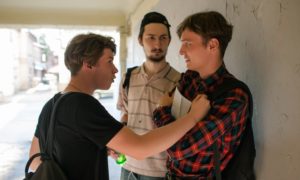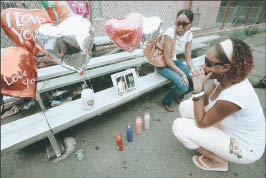 |
|
Remembering: Delaware State University students Amani Abda-Salaan and Amber Green place balloons and candles at the Newark, N.J., playground where their friends were murdered. Photo: Jennifer Brown/The Star-Ledger |
By Doron Tassuig
Newark, N.J.—The schoolyard where the notorious killings happened is the largest in Newark, but with its gray concrete and episodic patches of weeds, it lacks the happy, youthful aura of a play area. Although surrounded by a pleasant, working-class enclave, it looks like the kind of place where something terrible could happen.
When four college students were gunned down execution-style along a wall here last August – allegedly by a group of four teens, one adult in his 20s and another in his 30s – this long-beleaguered city was thrust into a harsh national spotlight. If this was the next generation in Newark, people thought, the city truly was a lost cause.
Civic and community leaders responded with the kind of declarations you typically hear after youth tragedies. Everyone said they were fed up and ready to do something to steer the city’s young people away from violence.
Such declarations often produce little more than busy work masked as progress: rallies, speeches, committees, a little more money for some youth activities for a while.
So what will happen in Newark?
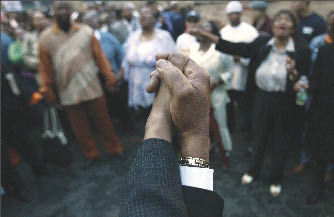 |
|
A Time to Pray: A week after four Delaware State University students were shot on the Mt. Vernon School playground, members of the Ivy Hill Neighborhood Association gathered for a prayer vigil. Photo: Saed Hindash/The Star-Ledger |
“Unlike other brutal crimes over the years in Newark, this one has not been forgotten,” says Micháela Murray-Nolan, executive director of Kids Corporation, a local nonprofit that runs after-school and summer academic programs.
Part of the answer is found at the Mt. Vernon School – the scene of the crime – on a recent Thursday afternoon, where children in the schoolyard gleefully play “Red Light Green Light 1-2-3.” Inside, youth worker Ryan Harris sits in a classroom helping Zakee Swann with his homework. They’re writing “This is fun,” although the paper only says “This is.”
“We haven’t gotten to the fun yet,” Harris explains.
The program they are in, New Jersey After 3, has expanded to several new sites because of the shootings. In addition, one of the city’s major funders of youth programs is helping providers explore how to improve staff training. And a commission is studying existing youth programs with an eye toward expanding and improving services.
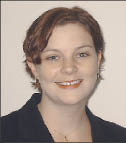 |
|
Murray-Nolan: Unlike other crimes, this one “has not been forgotten.” |
But don’t come here looking for a revolution; the changes are relatively small and subtle. “I don’t think anything magic is happening,” said Mamie Bridgeforth, chairwoman of Essex County College’s Social Science Division and a former city councilwoman.
In that way, Newark stands as a case study for this question: Can a violent incident galvanize a community to improve youth services?
Promises, Promises
A lot of people will be surprised to learn that Newark was on the comeback trail. Although it hemorrhaged residents for decades, the city now has the highest growth rate of any metropolis in the Northeast; its population increased by about 8,000 people – around 3 percent – from 2000 to 2006, according to the U.S. Census Bureau.
And it was getting safer. Preliminary FBI crime statistics for 2007 showed that the overall number of violent crimes – murders, rapes and assaults –dropped to 1,182 from 1,476 in 2006. That year, Democrat Cory Booker was elected mayor on a public safety platform.
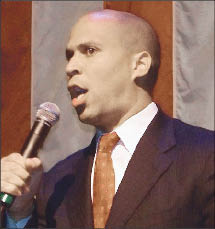 |
|
Booker: Elected on a public safety platform, he had to respond to the shootings publicly and repeatedly. Photo: Courtesy of Wikimedia/Bbsrock |
But the city “lost an actual percentage of [its] successful young people” in the Mt. Vernon schoolyard, says Murray-Nolan of Kids Corp.
The victims were four young adults who grew up in the city and went to public schools, then on to Delaware State University. Three of them died: Iofemi Hightower, Terrance Aeriel and Dashon Harvey. Natasha Aeriel, Terrance’s sister, survived.
Many people in Newark’s youth services community knew the victims and had worked with them, making their deaths particularly shocking for youth workers.
Terrance Aeriel had worked as a youth counselor for the nonprofit Unified Vailsburg Service Organization (UVSO), which runs an after-school program and summer day camp program at Mt. Vernon. He was also a leader in UVSO’s teen program and a member of the steering committee that laid the groundwork for the program’s year-round teen center.
The shootings set off a flurry of civic activity:
• Forums were held at which former juvenile delinquents spoke out about the pressures and lures of the street.
• The media flocked to an event for Stand & Deliver, a communications workshop in which one of the victims had participated.
• The Victoria Foundation, which funds many of Newark’s youth service providers, held a meeting with its grantees to ask what they needed.
• Dr. Robert Johnson, co-chairman of the Committee on Youth Development for the mayor’s Council on Family Success, started getting phone calls prodding him to produce recommendations quickly.
• Gov. Jon Corzine (D) and Attorney General Anne Milgram promised a broad new anti-violence plan.
The question is whether such pronouncements and activities will produce significant changes that last.
Mapping Youth Services
In a way, one of the most striking courses of action here has been to stay the course. Before the shootings, Maria E. Vizcarrondo, director of the Booker administration’s Department of Child and Family Well-Being, had asked Johnson, interim dean of the New Jersey Medical School, to co-chair the youth development committee. The other chairman is Felix Rouse, executive director of the Boys & Girls Club of Newark. The dozen or so other members include Vizcarrondo and representatives of the city’s employment, mental health, education and juvenile justice fields, as well as community leaders.
When the committee looked at youth programs, it found that, contrary to conventional wisdom, Newark’s problem was not really a lack of resources; the city had lots of youth programs. The problem was that the services were highly decentralized, and no one made sure they were effectively administered – a common issue in many communities. No one knew, for instance, whether programs were efficiently distributed geographically, or if some neighborhoods had surpluses and others had big gaps. No one knew if there was a glut of, say, after-school programs for elementary school children and a lack of evening activities for high schoolers. No one knew how much the services were being used or how well they worked.
The committee launched a survey of providers to determine the range of services available, and plans to follow up with an assessment of access and use.
(For more on how communities might address this issue, see Tutor/Mentor Connection in Chicago, which has created online maps that show the locations of mentoring programs, poorly rated schools and incidents of violence. Go to http://www.tutormentorconnection.org, click on Program Locator, then T/MC Map Gallery.)
After the shootings, Johnson says, people called to say, “We want you to tell us what you’re going to do about this issue,” and asking him to “come before [the] city council and say that what we’re doing is going to end gang violence.” The committee chairman was not pleased. “When you get mission creep as a result of a current event, you don’t get anywhere,” he says.
Rouse, of the Boys & Girls Club, the committee co-chair, concurs: “We’re just trying to pump the brakes and say, ‘Wait a minute – there’s no need to rush.’ ”
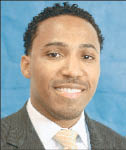 |
|
Rouse: “There’s no need to rush.” |
Typically, a committee like this would scurry to produce some 10-point plan to tackle the city’s youth violence problem, which would garner media attention and give everyone the sense that something was being done. And therein lies the drawback to a community energized by a tragedy: People who suddenly start paying close attention to an issue don’t necessarily know the best course of action. When the quick fix doesn’t pay off, the cause gets put on the back burner until the next disaster.
“I’ve been in this business long enough to see these things come and go,” Johnson says. “Public attention never results in any permanent action. Never.”
The committee stuck to its plan to conduct a systematic assessment of Newark’s youth services, and recently chose an assessment tool.
Meanwhile, others have moved to make quicker changes.
After-School Boost
Newark already knew it had holes in its after-school services. The shootings compelled government leaders to fill some of them.
They targeted New Jersey After 3, a statewide public/private partnership founded in 2004 that awards grants to schools and community-based organizations to operate after-school programs. The Mt. Vernon School, where the shootings took place, got a New Jersey After 3 program in 2005, run by UVSO. The program serves 243 children, says Principal Bertha Dyer.
“I just love the program,” she says.
In the wake of the shootings, the state provided $750,000 to boost youth after-school programming elsewhere in the city. By September, New Jersey After 3 had inaugurated nine new sites in Newark, for a citywide total of 24 and a statewide total of 107.
Unless more city matching funds come its way, however, New Jersey After 3 doesn’t have plans to expand to more Newark sites, said Mikaela Levons, executive assistant of the initiative.
Staff Training
Another way to capitalize on the energy that follows a violent tragedy is to identify gaps in services, which is the course taken by Victoria Foundation.
The foundation convened its grantees soon after the shootings, and several common concerns “bubbled up,” says Executive Officer Irene Cooper-Basch. They included safe transportation to and from after-school activities, and staff development.
“A lot of people in these organizations don’t necessarily have the type of training that would be helpful” to combat youth violence and the lure of gangs, Cooper-Basch says.
As with most communities, there aren’t many local opportunities for formal education and training in youth work. Essex County College offers an associate degree in human and social services and a certificate in human services, the latter of which caters to many employees of the city’s Department of Family Services, according to Bridgeforth of the social science division.
But to work in an after-school program in a Newark public school, all one needs is a high school diploma. Among “indigenous groups” like storefront churches, Bridgeforth says, staffers might not even need that. The institutions don’t have the money to hire people with advanced degrees or to pay for professional development.
“Those are the people that need the training,” she says.
When Victoria’s grantees met again in January, nine of them decided to form an Adolescent Youth Working Group, with $30,000 in support from the foundation. The money will go toward bringing in experts to speak with the working group and taking trips to see how such issues as transportation and training are tackled elsewhere.
Government Services
On the government side, Corzine, who had long planned to offer a strategy to deal with New Jersey’s gang and gun problems, hurried his report along after the shootings. The strategy, released in October, deals with law enforcement, recidivism and prevention.
The law enforcement piece involves mapping crime trends to identify hot spots. The recidivism plan focuses on several aspects of prisoner re-entry into the community, including helping ex-offenders get jobs and driver’s licenses. The prevention piece aims to coordinate the delinquency prevention efforts of various state agencies by appointing a director of prevention strategies, and to restructure the state’s statistical analysis center to improve evaluation.
What the plan does not include is any new funding: All the money would come from participating agencies’ existing budgets.
That says something about the limits of community galvanization. Laura Amerman, program director for Stand & Deliver, notes that a few months after the media flooded the Stand & Deliver event to hear students speak about their fallen friends, the organization held another youth event – and no news media came.
Still Searching
Back at the Mt. Vernon School, a few leaders of Newark’s philanthropic community met early this year with Dyer, the principal, as well as representatives of the Trust for Public Land and the Greater Newark Conservancy, to talk about refurbishing the school’s enormous courtyard and dedicating it to the shooting victims. They’re working with students to create a safe, appealing space for kids. A memorial garden ceremony was held in the spring.
A garden, however, is not the answer. If you ask Newark’s youth-service providers whether they think some lasting good will come from the Mt. Vernon shootings, you hear answers tinged with uncertainty.
For one thing, Newark needs a lot beyond youth services. “Newark needs better fiscal management,” says Murray-Nolan of Kids Corp. “It needs less guns and more fathers. … It needs a greater community emphasis on education. And jobs. Oh God, jobs.”
At the same time, advocates talk about a stronger sense of commitment and togetherness. They display an unusual optimism. “There’s a clear understanding that everyone has to do more,” says Robert “Mike” Farley, executive director of Unified Vailsburg Service Organization.
“There’s a sense of momentum in the city,” Murray-Nolan says.
If Newark’s response to the Mt. Vernon tragedy has a theme, it’s that even in an environment of political panic and community urgency, the reaction has been deliberate. Between Johnson’s refusal to rush his committee’s findings and the Victoria Foundation’s thoughtful strategic planning, community leaders have insisted on taking purposeful – not purely reactive – steps.
The potential upside of this approach, and the reason for the optimism, is that it increases the chances that Newark will channel the energy from the shootings’ aftermath in the right direction. The question is, when youth agency leaders figure out what they need, will the public still be interested in making sure they get it?
Contact: Dr. Robert Johnson (973) 972-4538; Felix Rouse (973) 242-1200; Mike Farley, UVSO (973) 374-2000; Shannon Boehmer, New Jersey After 3, (267) 241-5824, sboehmer@njafter3.org; Kids Corporation (973) 877-0980, http://www.kidscorporation.org.
Doron Tassuig is news editor at the Philadelphia City Paper.




